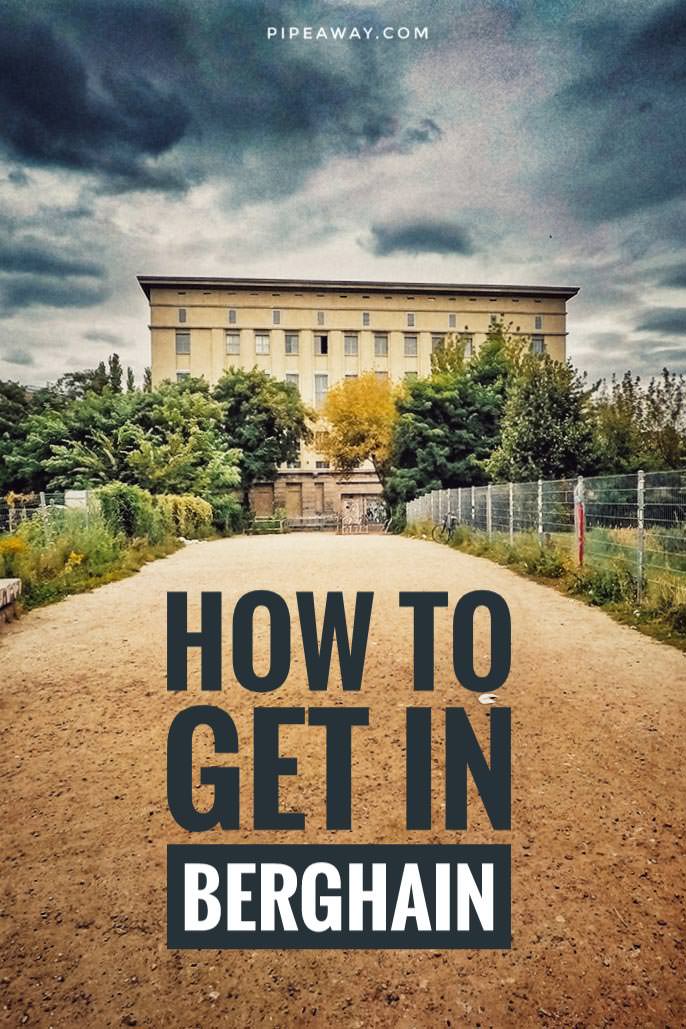A long queue of partygoers hoping to get inside Berghain. The strictest bouncers of the Berlin nightlife scene. Sticker on camera. Stamp on the arm. Darkness. A sound system that transforms you into a droplet of a dancing ocean. Hardcore techno. Hardcore sex. Bananas on the counter. Mushrooms in socks. Poppers in the air. Sweaty torsos. Couples. Threesomes. Gangs. Bangs. Freedom to be alone, or together. Penetration I wasn’t counting on… These mental snapshots blurred into my memory of Berghain, the world’s most intense club.
This ultimate Berghain guide is the first-person account on the experience of getting through the doors of Berlin’s most guarded club
Berghain never lacked fans. From those lining up in front of it and then rocking inside the techno womb, to those honoring the club at home by constructing Lego Berghain or a house for songbirds (Birdhain, it is), Berlin’s most notorious club always had friends who celebrated it as a shelter.
Even during the COVID pandemic that forced nightclubs to call a halt, Berliners couldn’t live without Berghain. Virginie Kypriotis developed an augmented reality app that lets you Enter the Club at home.
Berghain reopened in October 2021. But a year later, not for the first time, the club was rumored to close down indefinitely. FAZEMag pulled the story out of the journalist Jürgen Laarmann‘s question-mark Facebook status, and very quickly world media picked it up.
Even if the club’s future program quickly debunked Berghain’s closure as a rumor, the news caused quite a stir on the scene because Berghain overgrew the boundaries of just a place where people go to unwind. It became an undeniable institution.
In this ultimate Berghain guide, learn everything you need to know about the temple of techno and debauchery! Have all your Berghain questions answered, including what is so special about it, why is it so hard to get in, and what happens inside Berghain’s dark rooms!
This first-person account of getting into Berghain might not necessarily teach you how to hack your way through the doors guarded by seemingly merciless Berghain bouncers. But it could hopefully encourage you to try to experience Berlin’s most exclusive and inclusive club.
So, let’s deconstruct the mystery: how to get into Berghain?
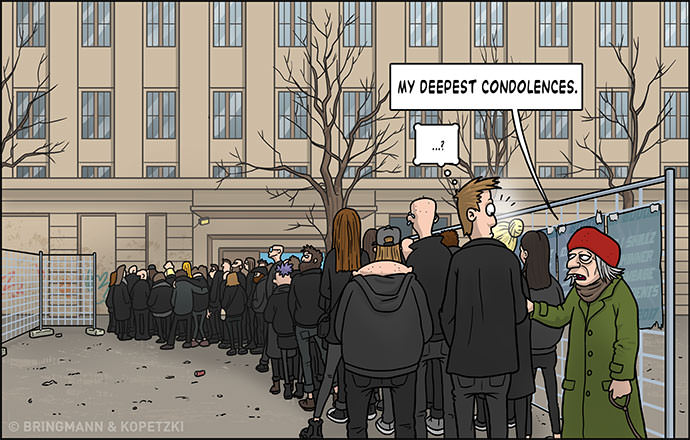
The cult of Berghain
With parties extending from Friday till Monday, Berghain always offered an anti-universe to the working class of the German capital. It is probably the most outstanding outcome of the Berlin movement that erased the boundaries of nightlife, normalizing partying during the day.
Endless queues that could be seen in front of the club even on Sunday morning, when “decent” citizens should rest or pray, gave Berghain the often-mentioned religious aura.
Similarly to Bible teachings, we could say that it is easier for a camel to go through the eye of a needle than for a sinner to enter the kingdom of Berghain. Thumb up or thumb down by the famous Berghain bouncer Sven Marquardt became the mysterious “word of God”, the measure of worthiness to join the most unusual Sunday mass.
After you accepted the veneration and a set of rituals that should not be questioned, DJ prophets spread novel ideas from the techno altars, paving the way to the development of Berghain in cult proportions.
The movement may not have promised eternal life, but the idea of eternal nightlife already seemed magnetic to those who wanted to escape the reality of the working week.
Snaking in front of the imposing building, hundreds of people wait. Maybe just like in the Stalinist era, when the government campaigned against religion even by experimenting with a continuous working week, these could have been just slaves exercising the labor discipline. In fear of being late to work, to stamp their card at the entrance of the power plant, they would have been surrendering to intensive labor, with forced overtime.
But here, at Berghain, machines went silent a long ago and were replaced by even louder speakers that laugh away the whole concept of labor and rest. The governmental experiments with productivity failed, and the queuers defended their own revolution, against the exploitation by the workplace or church simultaneously.
Find more ideas on things to do in Berlin during the daytime here.
Background of no-curfew techno
Since the 1990s, nightlife has been a major force drawing visitors to Berlin. But the insomnia of the sleepless city started five decades earlier, after the Second World War.
On the outskirts of the rivalry between the USA and the Soviet Union, marked by arming up, propaganda campaigns, and a space race, the divided German capital had a cold war of its own.
In West Berlin, bars had to close at 9 p.m., while East Berlin establishments could work until 10. The West pushed their official closing time one hour later, and the East responded with a countermeasure. In June 1949, West Berlin left the circumvention by completely abolishing the curfew.
After the fall of the Berlin Wall in 1989, East Berlin joined the idea of staying “always open”. But eliminating the closing time was just a part of the puzzle that secured mythical status to Berlin’s club culture in the 1990s.
The abandoned buildings, such as factories, power plants, warehouses, and bunkers, the emptied monuments of forgotten industries, became homes to non-stop reunification parties celebrating freedom.
The young music genre that originated in 1980s Detroit would eventually develop here into what would become known as Berlin techno.
| Tip
✨ Dive deep into Berlin’s club scene with this guided tour
What exactly is Berghain?
Berghain is a nightclub in Berlin. Besides being a major electronic dance music venue, the club also hosted a variety of non-clubbing events over the years, such as art exhibitions, fashion shows, and even ballet performances.
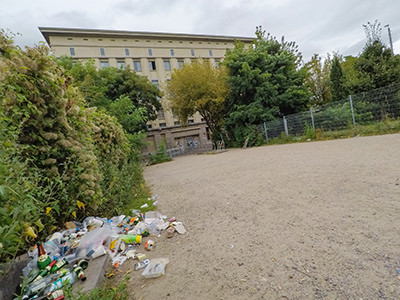
At a lengthy 2016 court trial with the Ministry of Finances, which claimed that clubbers visit Berghain mainly to get high, the venue succeeded in arguing that visitors of a classical music concert could achieve an intoxicating effect from a Mahler symphony the same as clubbers could from a DJ set.
Even after explaining in detail what is going on in their sexually charged dark rooms, Berghain managed to defend its business as a high culture. It became the first Berlin music club to be labeled as a cultural institution (sharing the status with theaters, museums, and concert halls), and not as an entertainment venue (like cinemas, casinos, and brothels).
This decision lowered Berghain’s taxes from 19 to 7 % and pushed toward the recognition of the entire Berlin clubbing scene as an essential element shaping the city’s identity.
Since 2021, Rave the Planet collective (including Dr. Motte, the inventor of Love Parade, a free-access techno event whose peace protest attendees in the 1990s grew from 150 to 1.5 million) advocated for the protection of Berghain and other landmarks of Berlin techno under the UNESCO’s World Heritage Sites list.
Learn more about Berghain in the Kindle edition of the book "Berghain: The World's Most Legendary Techno Club" by Mats Wurnell!
What does Berghain mean?
The literal translation of the word Berghain would be ‘mountain grove’. However, Berghain’s name is a portmanteau of something else, a word blending endings of the names of the two bordering Berlin districts once separated by a wall – Kreuzberg and Friedrichshain. While the first one is in former West Berlin, and the latter in East Berlin, the home of the club, the Berghain name meaning reflects the reunification spirit of the 1990s.
Standing at the end of the queue, I observe the colorful mix of characters hoping to enter Berghain today. If someone had brought me here blindfolded, without telling me the context, I wouldn’t have been able to guess that what these people have in common is the hope to enjoy some hardcore clubbing.
Old and young, showy and blended-in, straight and queer, cheerful and gloomy… It seems EVERYONE came over to try their luck.
For some, going to Berghain is almost a rite of passage, a challenge to tick off of their bucket list.
Four girls, probably in their teenage years, arrived armed with cheerleading pom poms, hoping to get noticed. And they were. Swiped left.
A guy in a black shirt experiences the same destiny. He came alone, wore all black, and against all available Berghain advice, his chances of entering today equaled zero.
They all end up walking the walk of shame, stripped down of pride like Cersei Lannister, passing by the queue of onlookers, all analyzing what they did wrong.
It has to be somewhat painful and humiliating. After hours of waiting in line, a few-seconds gaze by Berghain bouncer, and they head home.
Want to save on travel?
🎫 Ride public transport, visit sights of interest, and receive discounts of up to 50%
Berghain history
What did Berghain use to be?
The building of Berghain served as a coal-fired power plant, owned by the Swedish company Vattenfall. Built in 1954 in Stalinallee, the combined heat/power station became obsolete in the 1980s, went out of service, and was abandoned.
When did Berghain open?
At Am Wriezener Bahnhof location, a short walk away from Ostbahnhof train station, Berghain opened in 2004.
Berghain is essentially a 3-in-1 club. It includes the house of house (Panorama Bar), the mecca of techno (Berghain), and the basement of male lust (Lab.Oratory)
First, on October 15th, the Panorama Bar, which focused on house music, started operating on the top floor. On December 18th, the main floor of Berghain, the techno mecca, was officially launched.
Next year, the side entrance of the Berghain building opened to another special place – the Lab.Oratory. The club in Berghain’s basement aims at gay men with fetishes, organizing naked sex parties, leather and rubber nights, fisting events, and piss spectacles alike.
On March 23rd, 2017, the fourth space called Säule was inaugurated at the ground level of the Berghain building. Its focus is on more challenging, experimental electronics.
Who started Berghain?
Berghain owners are Norbert Thormann and Michael Teufele, two reticent friends and promoters who started organizing wild gay fetish parties called Snax in 1992 Berlin (Snax is still Berghain party night).
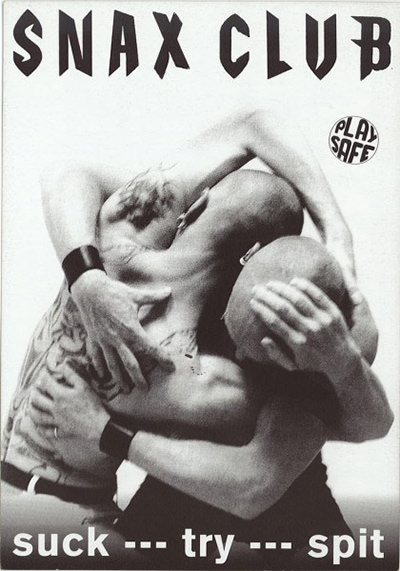
Their first home was Bunker, the illegal club in a former nazi shelter, but the nomadic party then moved around various Berlin locations.
In 1998, Thormann and Teufele managed to settle down in a former train repair depot in Friedrichshain, on the banks of the Spree river. Here, they founded Ostgut, the club that would still host hardcore men-only parties but would also be inclusive of other genders and sexualities. Ostgut would launch both Panorama Bar and Lab.Oratory, and be an early version of Berghain.
In January 2003, the city decided to demolish the railway zone, to make space for a stadium – O2 World Arena (today Mercedes-Benz Arena). Ostgut was forced to organize a farewell party. It was legendary, it lasted 30 hours and ensured that the club would not get forgotten.
At a new location, on the other side of the train tracks, Ostgut would resurrect as Berghain in 2004. At first, Thormann and Teufele would be renting the thermal power station, but in 2011, they’d become the rightful owners. The company that runs Berghain still bears the name – Ostgut GmbH.
Berlin club industry statistics Clubcommission Berlin, the network of creative companies in Berlin’s music industry, conducted a study in 2019, which concluded that out of 13 million tourists in Berlin in 2017, 3 million were club tourists. In a year, they contribute 1.5 billion euros to the city’s economy. According to the survey, the Berlin club experience is not just a reason to travel to the city, but also to call it a permanent home. An impressive 23 percent of clubbers living in Berlin decided to move there because of the city’s club and event scene. The study showed that every third club in Berlin bans taking photos as a measure to ensure the audience’s feeling of comfort. As for door policies, 48 percent of clubbers have been refused entry to a club at least once.
Berghain artists
So who DJs at Berghain? Artiom Dashinsky, an avid dance music fan, analyzed more than 10 thousand bookings at nearly one thousand Berghain parties between November 2009 and April 2021, to find out who were the top DJs in the Berghain club lineup.
Among almost 3,000 names that appeared on Berghain running order, those that played more than 100 times are Boris (123), nd_baumecker (121), Norman Nodge (114), Marcel Dettmann (112), Ben Klock (106), Tama Sumo (106), Nick Höppner (105), Fiedel (104), and Steffi (103).
The top labels in the same period were, predictably, ostgut ton (1217), followed by figure (124) and running back (107).
The muffled sounds of the party from the building mix with the whispers of the people waiting in the queue. Everybody learned the lesson: in front of Berghain, you do not make noise!
“Heeeey, Ivaaaan!”, a cheerful voice breaks the silence. That’s Marcos, an outgoing 40-something black guy I met two days before at one of the Folsom Berlin parties. He worked there as a so-called runner, and on Sunday morning he still had the energy that fit the job.
“Come on, we won’t queue”, he says.
I follow him to the front, but my mind starts to second-guess. He is black, loud, and now wants to cut the queue. Doesn’t that make him undesirable in the eyes of a Berghain bouncer, according to all the info circulating online? Will this be a mistake?
On our way to the front, he stops by the people queuing, and showers them with loud comments on their appearance, almost like conducting interviews for an invisible red-carpet camera. He is a funny guy, but I start to doubt that grabbing so much attention is a good idea.
There is this older lady, maybe in her 60s, dressed in a sporty outfit, but with full-on make-up. “Did you come for jogging?”, Marcos asks, laughingly.
She seems offended at first. But he then explains that he loves her style, and offers her his “runner’s badge”.
I am surprised by how people tolerate our elegant advance all the way to the metal entry barriers before the club door. Marcos is so loud that nobody wants to even object and risk the door rejection due to conflict.
Finally, we set our position next to a long-hair Aussie called Mitch. “I don’t like long hair usually, but yours I like”, Marcos says. And that’s all it took to anchor ourselves at the front end of the queue.
Berghain inside: the architecture of the maze
Berghain building was constructed in 1953-1954, in the Stalinist style of architecture, also known as Socialist Classicism.
Berlin-based Studio Karhard (another portmanteau, for Thomas Karsten and Alexandra Erhard) cleared the cube structure of turbines, generators, and other power station equipment, and gave the four-stories building a facelift in 2003. With raw concrete and steel as materials, the unpolished industrial feeling of the Berghain interior was kept. Over the years, additional tweaks were made, such as adding the smokers’ lounge, ice-cream parlor, and coffee bar.
Berghain is a gigantic cruising ground. It has corners and nooks to separate oneself from the crowds, dark rooms to immerse in, and unisex bathrooms for something in between
The 7,300 square meters of space are dominated by a former turbine hall of the power station with 18-meter-high ceilings. Now it houses Berghain’s main dance floor and one of the world’s most powerful sound systems, installed by Function-One.
The former control room of the electrical plant became the Panorama Bar. Its distinctive feature is tall windows with blinds that occasionally, at the right music accent, open up and bathe the partygoers in the bright morning light.
Lab.Oratory in Berghain’s basement is marked by a maze of cages, gloryholes, slings, benches, and other sex equipment that follow its hardcore vibe.
But with no dead ends, the entire Berghain layout provides a significant, flowing cruising ground. The club includes many corners and nooks to separate oneself from the crowds, dark rooms to immerse in, and unisex bathrooms for something in between.
Virtual peek inside Berghain Without many photographs of the club circling around, and with the shakiest and grainiest videos by those who broke the no-recording rule, your best option of checking out Berghain from inside without the risk of being bounced off is - a virtual visit. One avid fan recreated the club from memory in Minecraft, and it’s quite an impressive reconstruction. Your second option for feeling the atmosphere is playing the Hitman 3 video game where a bald assassin is sent on a mission to kill a DJ in a techno club inspired by Berghain.
Secret secretions at Berghain toilets
The eviction of mirrors from Berghain’s restrooms was intentional. It confronts the idea of narcissism as such, but also disables seeing oneself as being too wasted to party.
However, Berghain toilets became the social center of parties for some. The architect explained that minimalist-designed Berghain bathroom stalls maximized space. They were built to accommodate up to six people.
With enlarged capacity, toilets became places for deep conversations, drug trade and consumption, as well as sexual encounters.
At the center of many of Berghain’s urban legends is a fascination with urine. Some of these are possible facts (such as feeding a Berghain toilet-regular known as Piss Goblin with one’s urine), others are very creative fictions (such as the urban legend that Berghain’s urinals are directly connected with “golden showers” at Lab.Oratory).
One woman collected Berghain visitors’ urine for a fact, though, 1,000 liters of it! During ten weeks, the artist Sarah Schönfeld asked clubbers to donate their piss for an art installation called “Hero’s Journey (Lamp)”. A glass vitrine filled with urine was displayed in Berghain as a part of the club’s 10th-anniversary exhibition.
What happens inside Berghain darkroom?
Well, wouldn’t we all like to know? Berghain darkroom stories tantalize curious minds that try to imagine what sexual liberty looks like.
Frankly, with the forbidden use of cameras in the entire club, the boundaries of the dark room blur out. When visiting Berghain, you have to be ready for the fact that you might witness sexually explicit behavior in the bathroom or even on the dance floor itself.
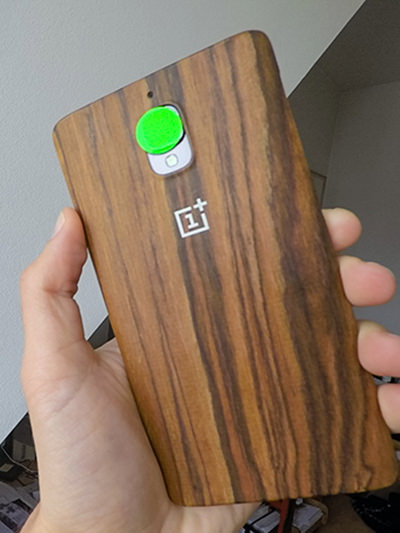
For an elevated feeling of anonymity, Berghain darkroom is a space to trade one’s sense of sight for the sense of touch. It eliminates voyeurism and highlights the experiment.
But what exactly happens inside Berghain’s dark room doesn’t get elaborated in detail, even in Reddit threads that often try to open the topic.
One Reddit user, describing his Berghain experience, gave a little hint for those lacking fantasy: “I went to the dark rooms and just wasn’t feeling getting sucked off by someone on their knees.“
Certainly, Berghain’s dark room, right next to the dance floor, is a place to let your inhibitions go. It’s not for the fainthearted, so if you managed to get through the Berghain door’s screening process but still lack total open-mindedness, try to focus your experience on better-lit (but still dark enough) areas, such as the bar or the dance floor.
How hard is it to get inside Berghain?
Berghain club queue can stretch for hundreds of meters. Club-goers often have to wait for hours in Berghain line, without any guarantee that their patience would be rewarded with a bouncer’s thumb up.
With an official capacity of 1,500 people and extra long opening hours, Berghain simply cannot just let everyone in. Besides being a pragmatic method for controlling the numbers of the crowd, selection at the door is a way to shape and protect the party atmosphere the club is known for.
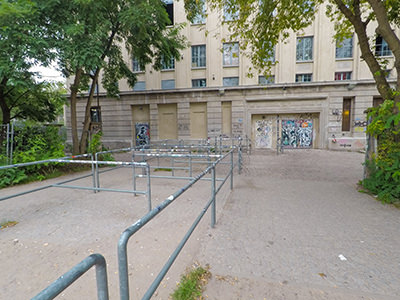
Getting into Berghain is a hard task simply because there is no official guidebook of rules that would secure club entrance.
As one could conclude from interviews with the iconic Berghain bouncer Sven Marquardt, the mystery comes down to understanding what Berghain is all about.
The reason behind the notoriously difficult door policy is the history of Berghain as a club that provided a safe space for gays and other outsiders, with no prejudice.
Berghain became the hardest club to get into simply because it tries to protect its clubbers from the judgemental environment they encounter in daily life.
They want everyone entering the space to be capable of handling the freedom of expression it comes with. That is why Berghain acceptance rate is supposedly less than 50 percent.
The picky Berghain guards will let you enter only if you fit the club’s energy; stay unpretentious and don’t try to impress. Just be yourself.
“How old are you, Mitch?”, Marcos asks the Australian, pretending he is a bouncer himself.
“What do you think?”, Mitch delays his answer, but then he says – 24.
Marcos doesn’t believe him. Mitch looks older. But he says he plans to give up cigarettes. Party life takes its toll.
“Never come with more than one person”, the invisible warning flashes in my head. But here I was, stuck with loud Marcos, and confused Mitch, pretending we were all some old pals in front of the Berghain’s doorman, the real-life lie detector.
Mitch, also familiar with “strict” Berghain rules, whispers to Marcos’ ear: “If they ask, I came alone, OK?”
Marcos carelessly laughs at his remark, squeezing him under his arm: “What do you mean, babe? We are a couple!”
And me? I’ll be a threesome companion, it seems.
Mysterious Berghain bouncer: Who is Sven Marquardt?
With club owners avoiding media exposure, Berghain’s head bouncer Sven Marquardt (60) became a celebrity of his own, probably the most famous security guard in the world.
It is an interesting coincidence that a doorman at Berghain, a club that doesn’t allow photography, has a day job – as a photographer. With his analog Nikon camera, Sven takes black-and-white photos of people who make the edge of Berlin.
Born in 1962 in East Berlin, a year after the wall was built, Berghain’s gatekeeper had a real-life lecture on being a misfit. Due to his appearance, in those years he wasn’t allowed to spend time in the city center.
Heavily tattooed and pierced, today he decides the fate of misfits in front of Berghain doors. But contrary to popular belief, it’s not all about appearance.
At the launching of his autobiography “Die Nacht ist Leben” (“The Night is Life”), Sven Marquardt explained that the definition of Berghain clubber is quite open: “We also take guys in masks and kilts, or Pamela Anderson blondes in run-of-the-mill high-street outfits who tag along with bearded blokes, licking the sweat off each others’ armpits. That, for me, is Berghain.”
If you want to read the chronicle of Sven’s growing up as a gay punk in East Germany under the watchful eye of Stasi spies, over the nineties in unified Berlin spent taking drugs and clubbing, all the way to participating in the birth of Berghain legend, you can order the book here.
In the western world, sometimes we take our freedoms for granted, not even thinking about how many years it took to get here. Click on the links if you want to learn more about gay life in Cambodia, or the fight of ladyboys in Thailand.
Getting into Berghain – a game of unknowns
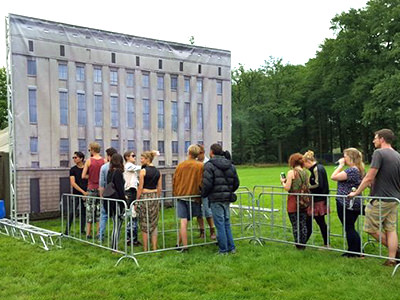
In 2016, the Dutch music festival Beyond created Berghenk. The one-off event was a Berghain mock-up, a facade of a non-existing club, with techno sounds coming from behind. They wanted to see if people would be ready to queue only to experience rejection by the bouncer at a party that never was. And the lines did form. Some of the clubber-wannabes tried many times, but nobody ever got in.
The festival claims that Berghain made Facebook remove their original post about the project which satirized the bouncing as an event itself. Well, it might have also been a copyright claim, as Berghain doesn’t like others profiting from using their name which became not only the synonym for great techno but also for the mystified door policy.
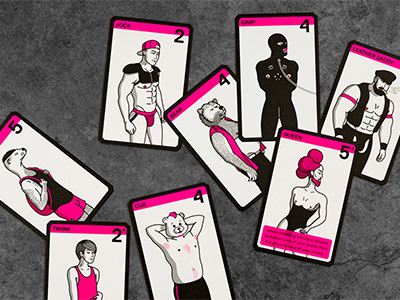
A year later, for instance, Swedish indie board game publisher Ninja Print created a card game based on letting people into a club. Originally named Berghain ze Game, it changed to Bergnein after the club’s first legal threats. Nevertheless, the publisher still lost the legal case launched by Sven Marquardt and had to pay the fine and cease production.
Copyright claims aside, there have been several projects trying to help Berghain fans practically. From Instagram pages updating on whether there is a long queue, to apps teaching you how to get into Berghain, amateurs and professionals tried to decode the entrance to the techno fortress.
The most known attempt at such is the Berghain Trainer, an interactive Berghain simulator developed in 2016 by Fabian Burghardt and Vincenz Aubry. They used face and voice recognition software to analyze your emotions while you do your best to answer the bouncer’s questions so you could enter virtual Berghain.
It was later discovered that the trainer randomly decided who would be let in. So even this project didn’t crack the mystery of getting inside Berghain, the task some were even ready to honor with a bribe of 100 Euros.
I somehow end up pushed to the front of our little trio. Marcos does seem to be a confident regular visitor, but he does break all the rules of the book. Mitch, I have no idea who he is.
“How many of you? Two?”, Berghain bouncer asks and offers an acceptable answer at the same time.
“Ermm…”, I hesitate, not sure how to respond. “I just met them”, I mumble.
He scans me, top to bottom, and for an unknown reason approves the entrance.
“Enjoy the evening, guys!”

How to get into Berghain
Numerous blogs and websites attempted to dissect Berghain’s brutal door protocol. None of those tips for getting into Berghain have been officially approved by the club. Unspoken “rules” on how to enter Berghain should always be approached with a grain of salt.
Berghain’s door policy might have even inspired Tinder! Swipe right translates as “you’re in”, and swipe left means “sorry, not today”
Berghain bouncers entitled to do the selection often joke with advice for Berghain face control that circles around. They know their job is purely subjective.
Sven and the team don’t even provide an explanation to the ones who have received literal “swipe left” at Berghain doors. The confusion happens when those who did not get in, and even those who did, start to use their personal example to deconstruct the Tinder-like Berghain door policy.
The only tip for getting into Berghain should probably be: “Stay true to yourself.” If they want you in, you will get in. If not, don’t cut your arms with broken glass (true story!), but walk away with decency.
Nevertheless, knowing that this doesn’t sound concrete enough to demystify the ethereal process, and having in mind that bouncers have long shifts so they might also appreciate more reading material to joke with, here’s another attempt to give you guidelines on how to get inside Berghain!
Berghain – how to get in: Top 8 tips
1. Berghain dress code: What to wear to Berghain?
First thing first: how to dress for Berghain? If there is a Berghain dress code policy, then it’s casual. Anything that will allow you to dance freely should be acceptable (that means no stiletto heels or flip-flops, for instance).
Thinking that mimicking Sven Marquardt’s style is a way to go is just plain wrong. Yes, you will see many club-goers wearing black-on-black, but Sven did show up on one of his shifts dressed in all white, just to mess up with everyone. He might personally not wear sneakers, but that doesn’t mean they are a forbidden part of Berghain attire.
On the contrary, staying true to yourself, and not emitting the energy that you are desperately trying to fit in, or even impress, is crucial.
In any case, Berghain has a cloakroom, and many visitors will leave most of their clothing there, and embrace partial or even full nakedness. The same as with no rules for dressing up, there are also no rules for undressing.
Finally, more than imposing some unwritten Berghain dress code, what bouncers are doing is essentially checking your vibe code.
If you still need encouragement for creating your Berghain look, check out some of the both male and female outfits that got into Berghain, as documented by the photographer Vincent Voignier in the “Nachtgestalten” project.
Mitch is wearing an all-black, unpretentious, and relaxed Berghain outfit, just like his messy hair. After we pass the thorough pat-down by the security, and they cover our mobile phone cameras with stickers, my new Australian friend admits that he managed to smuggle his mushrooms in. In his shoes.
Even if sometimes they strip the clubbers out of socks, bouncers cannot act on their intuition to the fullest all the time. Drugs, just like people, find their way into Berghain.
Engines need fuel. And the power plant’s main hall seems to be in full swing. Instead of the turbines, the vibrating bodies produce the heat, pumped by the most powerful sound system in the world.
The sonic apparatus, as claimed by Benedikt Koch, the person who installed it, operates only at 10-20 percent of its full capacity. He said that turning it up to full power “would be like getting a massage of every nerve of your body”.
You feel one with the music, you are inside of it, and it is inside of you. Human flesh rhythmically explores the darkness.
2. Berghain age limit: Does Berghain check ID?
The age limit for clubs like Berghain is 18, but normally you do not need ID to get in. The thing is that the conversation with bouncers will rarely get to the point where they feel they should let you in even if they are suspicious about your maturity.
According to the Clubcommission Berlin study, most of the club-goers in Berlin are aged between 21 and 40, with the average age being 30,2.
Berghain fits these statistics quite well, as its audience is predominantly in their thirties, so age questions should certainly not be asked at Berghain.
If you do get rejected at the door, take “nein” for an answer. Waving your ID in front of the bouncers will not have any influence on them changing the decision.
3. Can tourists get into Berghain?
If you look at one-star Berghain reviews, you will often read that the club doesn’t like foreigners. That is mostly based on the fact that some foreigners get rejected at the entrance, but cannot figure out the reasons, so they comfort themselves with what to them seems to be their biggest distinction – not being local.
Yes, tourists can definitely get into Berghain. And no, you do not need to spend a day learning poor German, just to impress the bouncers with your “Zwei, bitte” pronunciation.
Berghain doormen speak solid English, and they will certainly not measure your vibe by a vocabulary test.
4. Is Berghain racist?
Similar to the previous example, some rejected individuals would claim they fell victim to an Aryan door policy that counted their melanin production.
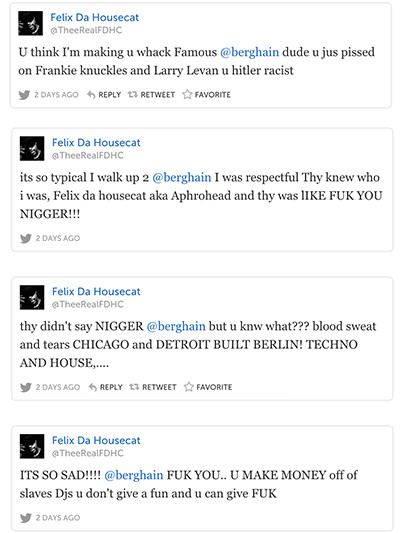
Among the more famous clubbers who criticized Berghain for racism was Felix Da Housecat, a black DJ and house producer from Chicago. In 2015, he was denied entry to Berghain and then spilled his outrage on Twitter, calling out “modern-day slavery” by “racist cunts”, drawing comparisons with the practices of Adolf Hitler and the KKK.
Besides this exaggerated public cry out, some unacceptable incidents did happen in Berghain. Such was the case in 2019, when a bouncer slapped Nico Limo, a person of color, and told them to go back to their own country. This member of the security staff was fired after the complaint.
As a general rule, Berghain certainly doesn’t discriminate nor tolerate discrimination on race. People of all colors and nationalities can be seen inside Berghain.
The third M of my Berghain evening shows up, Mario from the United States. I met this tall smart-looking Afro-American the night before, on a bus, returning from the Kit Kat Club. We engaged in some small-talk conversation, and he seemed to be a polite young man. I wasn’t expecting to see him at Berghain.
As soon as he sees me, he grabs my head and kisses me, rubbing firmly against my crotch. Erm, hello, Mr. Hyde?
“Do you know how long I was waiting for this?”, Mario asks, unleashed.
Well, that’s not so hard to guess. I just met you yesterday, dude, so I guess it has to be – since then?
At the extreme twist of this seemingly romantic encounter, he lifts me strongly in the air. He must’ve been 2 meters in height, and the view from up there, on the gallery next to the stairs to Panorama Bar, scared the shit out of me. I sincerely thought I would fly over the fence and crash in a thousand pieces on the ground floor, among the dancing crowd.
“Let me down”, I yell. He obeys but keeps on holding me tight.
He licks his finger, pushes his hand into my trousers, and penetrates me carelessly.
Mitch from Australia suddenly felt like a best friend of mine. He was standing there, observing our aggressive pas-de-deux. And I used him as an excuse to squeeze out of this situation.
“Look, Mario! Me and my friends, we just arrived… We will grab a drink, but you’ll be around here, right? We’ll see each other, for sure!”, I winked.
We never met again.
5. Is Berghain a gay club?
Pointing to the queer roots of Berghain, some online resources suggest that holding hands or even kissing a person of the same sex in the vicinity of bouncers would give you an advantage when your destiny at the door would be decided.
Well, Berghain is not a gay club today. It welcomes anyone from a wide spectrum of gender and sexual orientation. That means that it’s not important how you exercise your sexuality, as long as you come with tolerance and understanding for variety you would certainly witness inside Berghain.
If anything, acting gay when you are not would raise a red flag in the Berghain queue, as it goes against the idea of being true to oneself.
Lab.Oratory, the separate sex club, is the only dedicated gay space of the Berghain building, even if some of its evenings (such as Revolting) are also open to mixed crowds.
If you want to experience the gay fetish side of Berlin, consider visiting the Folsom Europe fetish fair!
6. Can you take a photo in front of Berghain?
If you plan to get into Berghain, taking a selfie while waiting in the queue is certainly not a good idea.
There is a strict no-photo policy in the entire club, so showing disrespect to that while waiting is not gonna be your best advertising.
Berghain doesn’t allow taking pictures or videos because it wants to protect the privacy of its visitors so they can experience unrestricted freedom. Putting a sticker over your cellphone camera at the entrance and threatening you with a lifetime ban if you remove it, is a friendly reminder that offenders are taken seriously.
#berghainfilter Photography prohibition at Berghain became such an intriguing topic that photos taken with Berghain stickers still on the camera lens became a valid document of partying. There are dedicated pages on Instagram and Tumblr reposting images made with the sticker (the so-called #berghainfilter). Among them, you can find “a picture that encourages your deep throat fantasies”, “selfie with a totally wasted French tourist”, “photo of the ladyboys in Panorama Bar”, and “even darker photo of a dark room”.
If you don’t want to get on Berghain’s blacklist, abstain from documenting your “best moments” and feed your social-media-fueled narcissism somewhere else. That being said, there are still 327 thousand Instagram posts with the #berghain hashtag.
Berghain did open the club’s official Instagram account in 2014, but only to remind you of the golden rule of switching off. If we exclude the 2022 social call for helping the Ukrainian creative community, the only photograph on Berghain’s Instagram is the one showing a sign that photography is forbidden – in English, French, Russian, and German.
View this post on Instagram
There are no mirrors or reflective surfaces in Berghain, and weapons are forbidden too. Somehow, my Berghain outfit showed a middle finger to both rules. I lost the shirt somewhere, and all I had on my chest now was a necklace in the form of a knife, made in a reflective material, sprinkled with “blood”.
A girl in Panorama Bar approaches me, fascinated. She touches my knife/necklace as if it came from another world or the future.
It seems easy to seduce gazes in Berghain. Even waiters engage in the behavior. At one of the bars, there are sandwiches and bananas on offer, coffee, mango or acai smoothie, you choose. Or the waiter’s flirty little eyes.
“Are you sincerely interested, or do you look at every customer like that?”, I ask.
“How could I not be sincere in front of a man like you?”, he says, while my stomach reacts to the cheesiness of his compliment.
The attitude still earns him tips.
7. Should you be going to Berghain alone?
Going to Berghain alone is absolutely acceptable. In fact, if you come in a wolf pack, greater are chances that all of you get rejected, simply because you would be judged as a whole.
However, there is no precise answer to how many is too many. Advice on not coming in groups of more than two is false. If you are the right fit, being in a group will not be a problem.
Certainly, hen and stag parties should consider not waiting in line for Berghain. Well, for the reasons of group mentality, as well as for probable alcohol pre-consumption and obnoxious behavior. It is indeed recommended not to produce unnecessary noise when queuing, and hen/stag nights do not seem to adhere to staying calm.
Getting into Berghain is much more easily achievable if you come sober. So you raise your chances by not coming in a company, of people, or bottles.
Mushrooms and alcohol kick in. Mitch, my Aussie pal, opens up like a book. He broke up with his girlfriend last week. Berghain sounded like therapy.
He is not gay, he says, but still ends up licking my entire torso, wiping the sweat off of my armpits, so “he could take it home with him”.
The straight Aussie lowers down his trousers only to show me the tattoo on his bum. He plans to make another one – a splashed Tinker Bell. Who needs fairies, after all, right?
For some reason, Mitch promises to give me a blowjob later in the evening.
He will disappear in Berghain’s crowd, just like Marcos and Mario before him, and never come back.
8. Conquering Berghain queue: What time to go to Berghain?
Some advise you to go to Berghain early, to raise your chances of getting in. Others tell you to focus on off-peak times of the night/day. The third ones cheer for Sunday as the best time to get into Berghain, as there are fewer tourists.
Berghain is just popular, and the door policy is strict, so none of these choices will secure your entrance per se.
Whenever you go, stick to the rule of waiting in the queue, and do not cut the line hoping this would get you inside Berghain quicker.
Even celebrities didn’t manage to see the Berghain Club inside
Without a VIP section in the club, and with a democratic approach to the dance floor, Berghain seems not to care about providing special treatment to famous people.
There have been quite a few celebrities that were rejected by Berghain. Among those who allegedly didn’t manage to get in are the pop princess Britney Spears, socialite Paris Hilton, actor Jake Gyllenhaal, indie rock star Florence Welch (Florence + The Machine), trans actor Hubertus Regout, and comedians such as Joe Hanson and Conan O’Brien. The latter one was asked to leave as soon as he approached the building at 100 meters, and the camera certainly did not help (see, no filming!).
Even Elon Musk, Tesla CEO and the world’s richest billionaire, didn’t manage to get a pass through the Berghain’s heavy doors.
However, that doesn’t mean that money cannot buy you an entrance to this club seemingly allergic to VIPs. If you book the place, you can party as much as you want.
At least two pop celebrities managed to have their pictures taken in nominally no-photo Berghain. Kylie Minogue performed her concert on a Tuesday night, and Lady Gaga promoted her album on a Thursday.
Some famous people did get into Berghain during a regular club night and were brave and proud enough to speak about it. Actress Claire Danes called it “the best place on Earth” when she spoke to Ellen DeGeneres. Singer Róisín Murphy, who danced among Berghain lesbians for hours after her official set, described it as a “mind-blowing experience”. Comedian Ari Shaffir testified on Joe Rogan’s podcast that spending the night among blowjobs “was the best”.
My sense of time disappears. It’s still day outside, but here in Berghain, minutes stretch in what seems to be a legit nocturnal world.
In the darkest part of the building, the infamous dark room, the atmosphere is electric. Your nostrils stretch together with widened pupils. It feels as if you are inhaling a giant bottle of poppers.
Lying in a leather sling, one guy readily receives a queue of horny men. His doors are open, and no bouncer is employed to regulate the gang bang.
Hedonism spills on the dance floor too. Some clubbers are dancing completely naked. One waves with an erected spear, threatening to poke someone in the eye.
Another sweaty bloke is leaning on the expensive speaker, enjoying the bass vibrating through his body. The trousers are down, around his ankles, and a girl kneels in front of him, not praying. She performs a blowjob to the rhythm of the world’s best techno.
In the corner of the dance floor, someone is typing on the phone. Recognizable orange and blue tones cut through the darkness. At the most hardcore party in Berlin, in a room full of interested guys, this one is trying to hook up on Grindr.
Berghain reviews by common people
Berghain reviews, especially those with one star, are a fascinating collection of experiences that usually stop at the screening process at the door. People who leave the worst Berghain reviews are typically those who never got in.
Well, there was that viral review by “Kyle W”, a Texas guy who claimed he visited Berghain and got disgusted by the scenes of hundreds of horny erection-bearers ejaculating on the floor just so they could slide on a slippery surface. The “worst Berghain review” was debunked as a total fake.
But as said, most people that leave one-star reviews on sites such as Yelp or Tripadvisor, have never even experienced the club. Let’s hear their reasoning!
Humphry from New York writes: “It felt sinister, and to be pointed away and directed like that with no words, really had strong parallels with Germany’s sinister past. I felt sick. Unethical discriminatory place, don’t support it. It’s for sheep who don’t know who they are.”
Med G. came all the way from Chicago, but the bouncers didn’t let them join the sheep, EVEN IF they had it written down on their list of things to do: “I explained to the guy I visit Germany only for 2 days and this was on my list. But I don’t think their English was good enough to understand me or their racism was blocking their comprehension.”
Leonidas P from Liverpool also expressed their disappointment with Berghain: “The way I dress never seems to matter, the way I look at them never seems to matter. They look down on you like you’re a low-life pariah and do not even converse. “You don’t get in” and point with a finger to go away. Three times this! Well, thanks a lot Berghain but you have really done it for me. Even if you begged me to go in there after the number of times your door pigs have ruined my holiday and my nights, I wouldn’t go. I really do not get how this place is still running and also who’s running it!”
JobitaD practically called upon UN intervention: “I’m even surprised the Human Rights Authority in Berlin have allowed Berghain to continue their business under such inhuman conditions. There should be a better reason why a nightclub should be popular. There are no moral principles or intelligence to such discrimination by Berghain.”
After he got rejected, Danny M from New York figured out that hot gay men were unwelcome at Berghain: “If you want to go here and are a gay man on his own, you will not be allowed in, no matter how attractive you are (as the doormen are straight and don’t care how cute guys are). If you have girls with you, you will get in. I was turned away, and then stood and watched the door policy. HOT guys by themselves got turned away. Average guys with average girls got let in. Is this what the nightlife scene in Berlin has become?! This is what Google says is the best party on a Friday night? And they let trash in and reject gorgeous people? I’m very confused. I’m fine with me not getting in but I watched tons of other people get turned away and they were HOT. This place is stupid as fuck lol.“
Best hotels and hostels near Berghain
If you want to maximize your chances of Berghain entry and minimize futile travels to the venue only to learn your entrance was denied, the best solution is to stay somewhere nearby. Staying close to Berghain will enable you to try your luck with another bouncer when their shifts change.
Ideally suited for partygoers, the best hostels in the vicinity of Berghain are Kiez Hostel (5 minutes walk away) and BackpackerBerlin (20 minutes walk away). Prices of dormitory rooms start at 25-30 Euros per night.
If you prefer the comfort of a hotel, consider staying in these hotels in the neighborhood! Schulz Hotel Berlin Wall at the East Side Gallery with its own bakery and beer garden offers single rooms already from 59 Euros. Nu Wave Hotel is the closest to Berghain, and their single room starts at 73 Euros. If you can afford a splurge option, consider Michelberger Hotel, where you can get a fantastic suite with a private sauna for 495 Euros per night.
For those who would love to stay on a boat, a single cabin at Eastern & Western Comfort Hotelboat starts at 79 Euros per night.
Follow the links for the most updated prices and photographs of all accommodation options. Or look for a second opinion on Tripadvisor!
Find the cheapest flights to Berlin on this link! During the Black Friday promotion, get a special discount if booking before December 5th, with the promo code "BFRIDAY40"!
Conclusion: Is Berghain worth it?
Going to Berghain is not for everyone. Hence, the strict door policy is a welcoming selection by those who have seen thousands of people wishing to participate and have chosen those who can.
The game of getting into the wildest club in Berlin doesn’t have written rules, and everyone could expect to be rejected by the bouncers now and then. It’s part of an intuitive ritual of creating a clubbing atmosphere that one could love or hate.
Getting inside Berghain means not being an outsider anymore. It’s a shelter for people disgusted by working marathons, social media madness, and outer expectations in general
Being refused an entry can be confusing, even hard, but nobody is alone in that. Taxi drivers, lining up in front of the club as soon as it opens, offer comforting services and rides to Berghain alternatives. There are plenty of places in Berlin to find one’s tribe.
For those who do get in, Berghain provides a decadent marathon of music and social encounters. Like any context that challenges boundaries, this is not the place for people with inhibitions. The curious and the courageous can expect the shameless nightlife tested to the limits.
Under a constant threat of real-estate developers’ plans, ever-rising running costs, and tiredness of Berghain owners in oiling up the club machine, nobody can expect it to last forever.
But in those moments of the night, when the whole building trembles with the sound of music and the sighs of fellow partygoers, the world with its working marathons, social media madness, and outer expectations ceases to exist. For those who felt like outsiders, Berghain turns out to be precious. Something like a home.
Did you like this peek inside Berghain?
Pin it for later!
This post was originally published on October 17th, 2022, and was updated on November 8th, 2023.
Disclosure: This post may contain affiliate links, which means if you click on them and make a purchase, Pipeaway might make a small commission, at no additional cost to you. Thank you for supporting our work! The cover image of this article, as well as in-text illustration in the same style, presents artworks by Nicola Napoli. The comic "My deepest condolences" is an artwork by Bringmann and Kopetzki.


